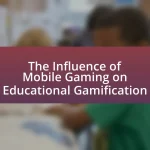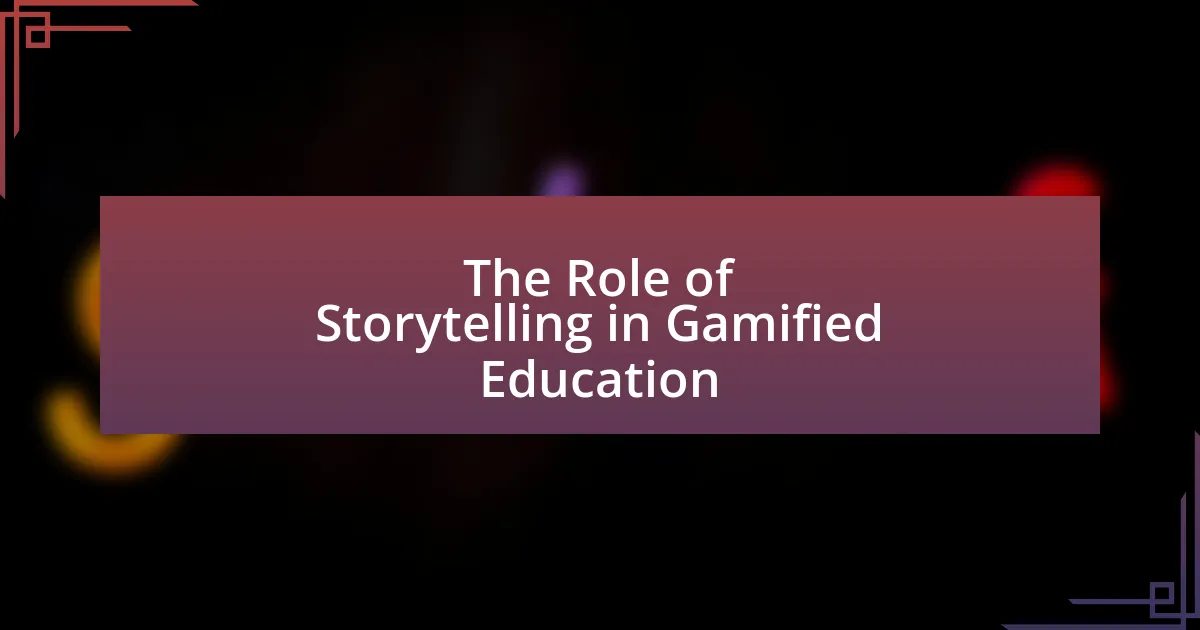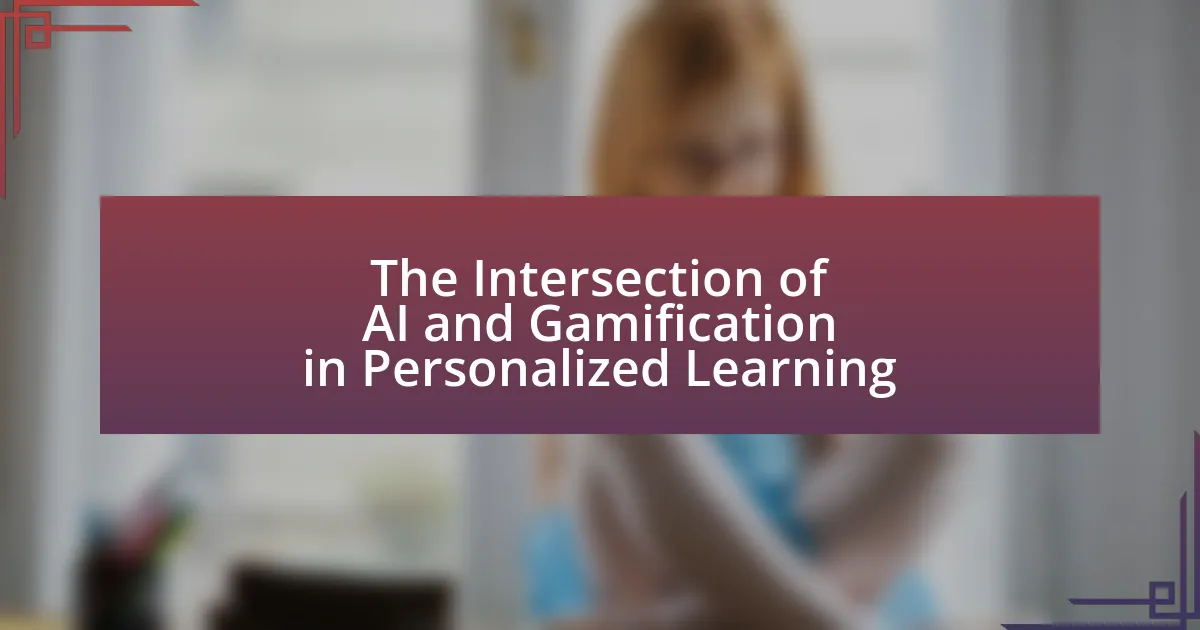The article focuses on the future of gamification in educational technology, highlighting its potential for growth due to technological advancements and its effectiveness in enhancing learning outcomes. It defines gamification in education as the integration of game design elements to boost student engagement and motivation, supported by research indicating improved retention and performance. Key elements such as points, badges, and leaderboards are discussed, along with the differences between gamified and traditional educational methods. The article also addresses current trends, challenges, and the role of technology, including artificial intelligence and data analytics, in shaping gamification strategies, ultimately emphasizing the importance of personalized learning experiences in modern education.
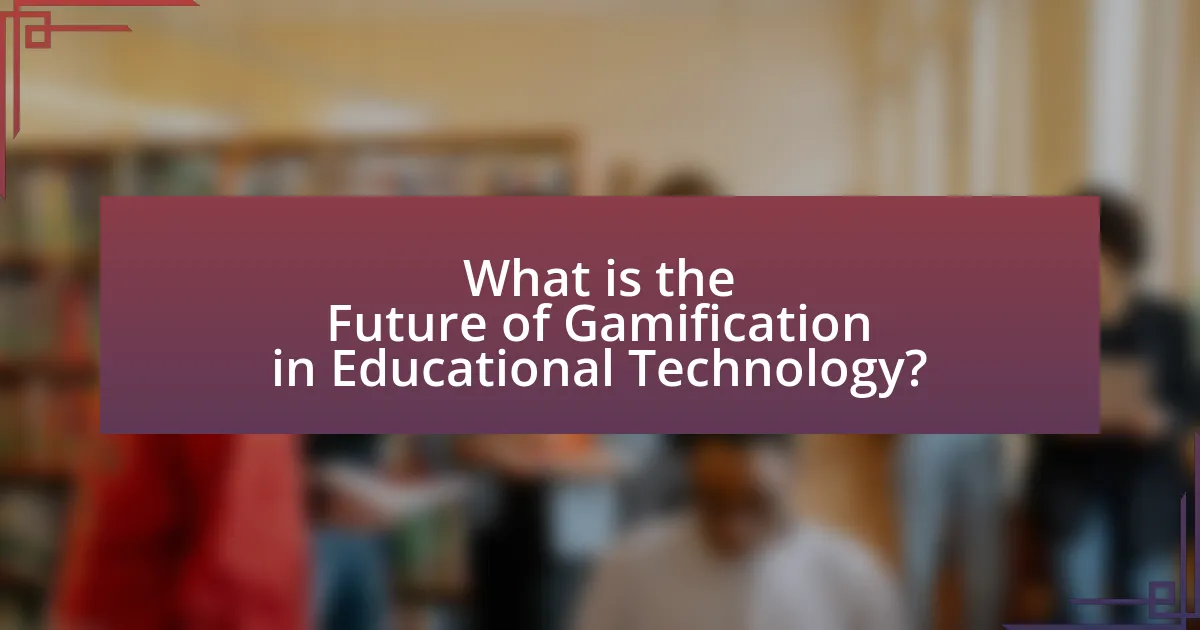
What is the Future of Gamification in Educational Technology?
The future of gamification in educational technology is poised for significant growth, driven by advancements in technology and an increasing understanding of its effectiveness in enhancing learning outcomes. Research indicates that gamification can improve student engagement, motivation, and retention of information, with studies showing that 80% of learners reported increased motivation when gamified elements were incorporated into their educational experiences. As educational institutions continue to adopt digital platforms, the integration of gamified learning experiences is expected to become more prevalent, utilizing elements such as rewards, challenges, and interactive content to create immersive learning environments. This trend aligns with the broader shift towards personalized learning, where gamification can be tailored to meet individual student needs, further solidifying its role in the future of educational technology.
How is gamification defined in the context of education?
Gamification in the context of education is defined as the integration of game design elements and principles into educational environments to enhance student engagement and motivation. This approach utilizes components such as points, badges, leaderboards, and challenges to create a more interactive and enjoyable learning experience. Research indicates that gamification can lead to improved learning outcomes, as evidenced by a study published in the “Journal of Educational Psychology,” which found that students exposed to gamified learning environments demonstrated higher levels of engagement and retention compared to traditional methods.
What are the key elements of gamification in educational settings?
The key elements of gamification in educational settings include points, badges, leaderboards, challenges, and feedback mechanisms. Points serve as a quantifiable measure of achievement, motivating students to engage with the material. Badges provide visual recognition of accomplishments, reinforcing positive behavior and skill mastery. Leaderboards foster a sense of competition and community among learners, encouraging them to strive for higher performance. Challenges present tasks that require critical thinking and problem-solving, enhancing the learning experience. Feedback mechanisms offer timely responses to student actions, guiding them toward improvement and deeper understanding. These elements collectively enhance student engagement and motivation, as supported by research indicating that gamified learning environments can lead to increased retention and academic performance.
How does gamification differ from traditional educational methods?
Gamification differs from traditional educational methods by incorporating game-like elements to enhance engagement and motivation in learning. Traditional educational methods often rely on lectures, textbooks, and standardized assessments, which can lead to passive learning experiences. In contrast, gamification utilizes elements such as points, badges, and leaderboards to create interactive and competitive environments that encourage active participation. Research indicates that gamified learning can improve retention rates and student satisfaction; for example, a study published in the Journal of Educational Psychology found that students who engaged in gamified learning scored 14% higher on assessments compared to those in traditional settings. This evidence supports the effectiveness of gamification in fostering a more dynamic and engaging educational experience.
Why is gamification becoming increasingly important in education?
Gamification is becoming increasingly important in education because it enhances student engagement and motivation through game-like elements. Research indicates that incorporating gamification strategies, such as points, badges, and leaderboards, can lead to improved learning outcomes; for instance, a study published in the Journal of Educational Psychology found that students who experienced gamified learning environments showed a 20% increase in retention rates compared to traditional methods. This trend reflects a broader shift towards interactive and personalized learning experiences that cater to diverse learning styles, making education more effective and enjoyable.
What trends are driving the adoption of gamification in educational technology?
The adoption of gamification in educational technology is primarily driven by the increasing demand for engaging and interactive learning experiences. This trend is supported by research indicating that gamified elements, such as points, badges, and leaderboards, enhance student motivation and participation. For instance, a study published in the “Journal of Educational Psychology” by Hamari, Koivisto, and Sarsa (2014) found that gamification significantly improves user engagement and learning outcomes. Additionally, the rise of digital natives, who are accustomed to gaming environments, further propels the integration of gamification in educational settings, as educators seek to align teaching methods with students’ preferences and technological advancements.
How does gamification enhance student engagement and motivation?
Gamification enhances student engagement and motivation by incorporating game-like elements into educational settings, which fosters a more interactive and enjoyable learning experience. This approach leverages competition, rewards, and challenges to stimulate interest and participation among students. Research indicates that gamified learning environments can lead to a 60% increase in student engagement and a 30% improvement in retention rates, as evidenced by a study conducted by Hamari, Koivisto, and Sarsa in 2014, published in the Journal of Computer Science. By making learning more dynamic and rewarding, gamification effectively motivates students to actively participate and persist in their educational pursuits.
What challenges does gamification face in educational technology?
Gamification in educational technology faces several challenges, including the risk of oversimplification of learning, lack of engagement among diverse learners, and potential misalignment with educational objectives. Oversimplification occurs when complex subjects are reduced to game mechanics, which can hinder deep understanding. Research indicates that while gamification can enhance motivation, it may not cater to all learning styles, leading to disengagement for some students. Additionally, if gamification elements do not align with curriculum goals, they can distract from essential learning outcomes, as highlighted in studies on educational effectiveness.
What are the common misconceptions about gamification in education?
Common misconceptions about gamification in education include the belief that it is solely about adding game elements, that it only appeals to younger students, and that it guarantees improved learning outcomes. Many educators mistakenly think gamification merely involves points, badges, and leaderboards, while effective gamification requires a deeper integration of game mechanics that enhance engagement and motivation. Additionally, the assumption that gamification is only effective for younger learners overlooks its potential to engage adult learners and diverse age groups. Research indicates that when implemented thoughtfully, gamification can lead to increased motivation and engagement across various demographics, as shown in studies like “The Impact of Gamification on Student Engagement” by Deterding et al. (2011), which highlights its effectiveness in diverse educational settings.
How can educators overcome resistance to gamification?
Educators can overcome resistance to gamification by actively involving stakeholders in the design and implementation process. Engaging teachers, students, and parents in discussions about the benefits and mechanics of gamification fosters a sense of ownership and reduces skepticism. Research indicates that when educators provide clear examples of successful gamification in similar contexts, such as improved student engagement and learning outcomes, resistance diminishes. For instance, a study by Hamari, Koivisto, and Sarsa (2014) found that perceived value and enjoyment significantly influence acceptance of gamified systems in education. By demonstrating tangible benefits and addressing concerns through collaborative efforts, educators can effectively mitigate resistance to gamification.

What are the Current Trends in Gamification for Education?
Current trends in gamification for education include the integration of adaptive learning technologies, the use of game-based assessments, and the incorporation of social and collaborative elements. Adaptive learning technologies personalize the educational experience by adjusting content based on individual student performance, enhancing engagement and effectiveness. Game-based assessments provide a dynamic way to evaluate student understanding, moving beyond traditional testing methods. Additionally, social and collaborative elements, such as leaderboards and team challenges, foster a sense of community and competition among learners, which has been shown to increase motivation and participation. These trends are supported by research indicating that gamification can lead to improved learning outcomes and higher student retention rates.
How are technology advancements influencing gamification trends?
Technology advancements are significantly influencing gamification trends by enhancing user engagement and learning outcomes through interactive and personalized experiences. For instance, the integration of artificial intelligence allows for adaptive learning systems that tailor challenges to individual skill levels, thereby increasing motivation and retention. Additionally, advancements in virtual and augmented reality create immersive environments that facilitate experiential learning, making educational content more relatable and engaging. According to a report by the New Media Consortium, 78% of educators believe that gamification can improve student engagement, highlighting the effectiveness of these technological innovations in educational settings.
What role do mobile devices play in gamified learning experiences?
Mobile devices serve as essential tools in gamified learning experiences by providing accessibility, engagement, and interactivity. They enable learners to access educational content anytime and anywhere, fostering a flexible learning environment. Research indicates that 85% of students use mobile devices for educational purposes, enhancing their motivation and participation in gamified activities. Furthermore, mobile devices facilitate real-time feedback and progress tracking, which are critical components of effective gamification. This integration of technology not only supports personalized learning paths but also encourages collaboration among peers, thereby enriching the overall educational experience.
How is artificial intelligence shaping gamification in education?
Artificial intelligence is shaping gamification in education by personalizing learning experiences and enhancing engagement through adaptive learning technologies. AI algorithms analyze student performance data to tailor educational content, ensuring that gamified elements are aligned with individual learning needs. For instance, platforms like DreamBox Learning utilize AI to adjust math challenges based on real-time student responses, promoting a more effective and engaging learning environment. This personalized approach not only increases motivation but also improves learning outcomes, as evidenced by studies showing that adaptive learning can lead to higher retention rates and better academic performance.
What are the emerging gamification strategies in educational technology?
Emerging gamification strategies in educational technology include personalized learning paths, real-time feedback systems, and collaborative challenges. Personalized learning paths allow students to progress at their own pace, adapting content to their individual needs, which has been shown to increase engagement and retention rates. Real-time feedback systems provide immediate responses to student actions, enhancing motivation and enabling timely interventions. Collaborative challenges encourage teamwork and social interaction, fostering a sense of community among learners. These strategies are supported by research indicating that gamification can significantly improve learning outcomes and student satisfaction in educational settings.
How are educators integrating game mechanics into curricula?
Educators are integrating game mechanics into curricula by incorporating elements such as point systems, badges, and leaderboards to enhance student engagement and motivation. This approach, known as gamification, leverages the competitive and rewarding aspects of games to create a more interactive learning environment. For instance, a study by Deterding et al. (2011) highlights that gamification can lead to increased student participation and improved learning outcomes by making educational tasks more enjoyable and goal-oriented. Additionally, platforms like Kahoot! and Classcraft exemplify how educators can implement these mechanics effectively, allowing students to earn rewards and track their progress in real-time.
What types of gamified platforms are gaining popularity in education?
Gamified platforms gaining popularity in education include learning management systems (LMS) with integrated game mechanics, mobile learning apps that utilize rewards and challenges, and online collaborative platforms that encourage competition and teamwork. For instance, platforms like Kahoot! and Quizizz leverage quizzes and interactive games to enhance student engagement, while Classcraft incorporates role-playing elements to foster collaboration and motivation among students. Research indicates that these platforms improve learning outcomes by increasing student participation and retention rates, with studies showing that gamification can lead to a 60% increase in engagement levels in educational settings.
How is data analytics impacting gamification in education?
Data analytics is significantly enhancing gamification in education by providing insights into student engagement and learning outcomes. By analyzing data from gamified learning platforms, educators can identify patterns in student behavior, such as which game elements are most effective in motivating learners. For instance, a study published in the Journal of Educational Psychology found that personalized feedback and rewards, derived from data analytics, increased student participation by 30%. This data-driven approach allows for the continuous improvement of gamified systems, ensuring they meet the diverse needs of learners and ultimately improve educational effectiveness.
What insights can educators gain from analyzing gamification data?
Educators can gain insights into student engagement, learning progress, and behavioral patterns by analyzing gamification data. This data reveals how students interact with gamified elements, such as points, badges, and leaderboards, allowing educators to identify which features motivate students and enhance their learning experience. For instance, a study by Hamari et al. (2014) found that gamification positively influences user engagement, suggesting that educators can tailor their approaches based on specific gamification metrics to improve educational outcomes. By understanding these dynamics, educators can refine their instructional strategies and create more effective learning environments.
How can data-driven decisions enhance gamified learning outcomes?
Data-driven decisions can enhance gamified learning outcomes by providing insights into learner behavior and performance, allowing for tailored educational experiences. By analyzing data such as engagement metrics, completion rates, and user feedback, educators can identify which game elements are most effective and adjust the learning environment accordingly. For instance, a study by the International Society for Technology in Education found that personalized learning paths based on data analytics significantly improved student engagement and achievement in gamified settings. This evidence supports the notion that leveraging data leads to more effective gamification strategies, ultimately resulting in better learning outcomes.
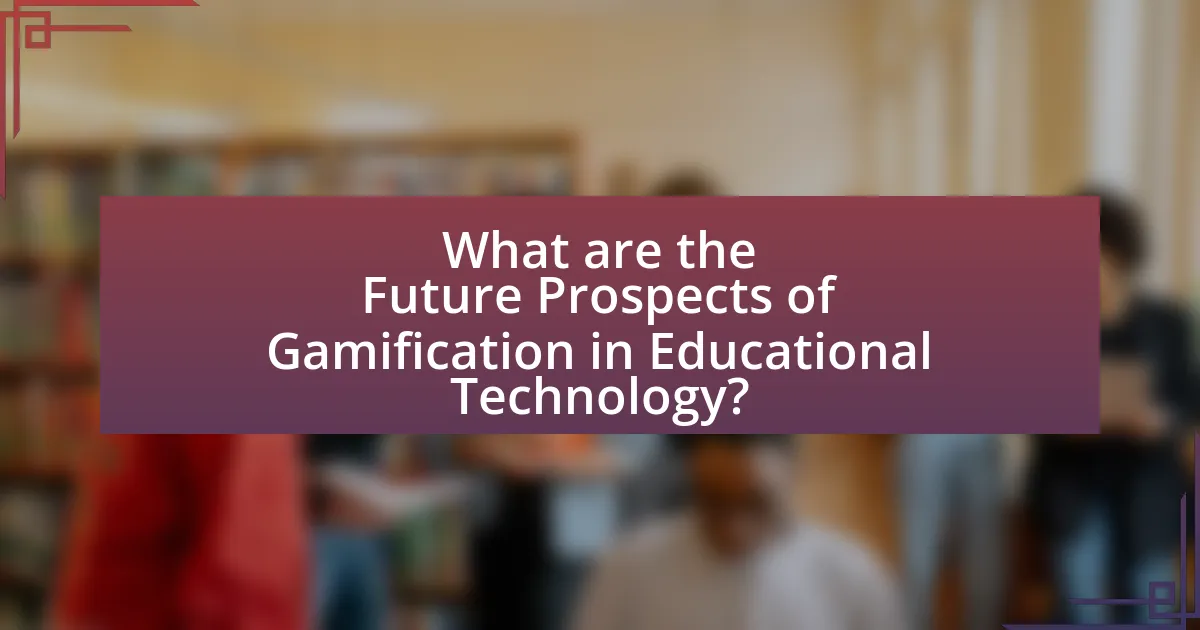
What are the Future Prospects of Gamification in Educational Technology?
The future prospects of gamification in educational technology include enhanced engagement, personalized learning experiences, and improved educational outcomes. Research indicates that gamification can increase student motivation and participation; for instance, a study published in the Journal of Educational Psychology found that gamified elements in learning environments can lead to a 34% increase in student engagement. Additionally, advancements in technology, such as artificial intelligence and data analytics, will enable more tailored gamified experiences that adapt to individual learning styles and progress, further supporting diverse educational needs. As educational institutions increasingly adopt these technologies, the integration of gamification is expected to become a standard practice, driving innovation in teaching methodologies and curriculum design.
How might gamification evolve in the next decade?
Gamification is likely to evolve significantly in the next decade by integrating advanced technologies such as artificial intelligence, virtual reality, and augmented reality into educational frameworks. These technologies will enhance user engagement and personalize learning experiences, making them more immersive and tailored to individual needs. For instance, AI can analyze student performance in real-time, adapting challenges and rewards to optimize learning outcomes. Additionally, the global gamification market is projected to grow from $9.1 billion in 2020 to $30.7 billion by 2025, indicating a strong trend towards its adoption in various sectors, including education. This growth reflects the increasing recognition of gamification’s effectiveness in improving motivation and retention among learners.
What innovations are expected to emerge in gamified educational tools?
Innovations expected to emerge in gamified educational tools include enhanced adaptive learning algorithms, immersive virtual and augmented reality experiences, and the integration of artificial intelligence for personalized feedback. Adaptive learning algorithms will allow educational tools to tailor content to individual learning paces and styles, improving engagement and retention. Immersive experiences through virtual and augmented reality will create interactive environments that simulate real-world scenarios, enhancing experiential learning. The integration of artificial intelligence will enable tools to analyze student performance in real-time, providing personalized feedback and recommendations, which has been shown to significantly improve learning outcomes. These innovations are supported by research indicating that personalized learning approaches can increase student motivation and achievement.
How will the role of educators change with the rise of gamification?
The role of educators will evolve to become facilitators and guides rather than traditional knowledge dispensers with the rise of gamification. As gamification integrates game design elements into educational settings, educators will need to focus on creating engaging learning experiences that motivate students through rewards, challenges, and interactive content. This shift is supported by research indicating that gamified learning environments can enhance student engagement and retention, as seen in studies like “The Impact of Gamification on Student Engagement” by Hamari et al. (2014), which found that gamification significantly increases motivation and participation in educational contexts. Consequently, educators will increasingly adopt strategies that leverage gamification to foster collaboration, critical thinking, and problem-solving skills among students.
What best practices should educators follow when implementing gamification?
Educators should follow several best practices when implementing gamification to enhance student engagement and learning outcomes. First, they should align game mechanics with educational objectives, ensuring that elements like points, badges, and leaderboards directly support learning goals. Research indicates that gamification can increase motivation and participation, with a study by Hamari et al. (2014) showing that gamified elements can lead to higher engagement levels in educational settings.
Additionally, educators should provide clear instructions and feedback, allowing students to understand the rules and objectives of the gamified experience. This clarity helps maintain focus and encourages a growth mindset. Furthermore, incorporating collaborative elements can foster teamwork and communication skills, as evidenced by studies that highlight the benefits of social interaction in gamified environments.
Finally, it is essential to regularly assess and adapt the gamification strategies based on student feedback and performance data, ensuring that the approach remains effective and relevant. This iterative process is supported by findings from the Journal of Educational Psychology, which emphasize the importance of adaptability in educational interventions.
How can educators effectively measure the success of gamification initiatives?
Educators can effectively measure the success of gamification initiatives by utilizing a combination of quantitative metrics and qualitative feedback. Quantitative metrics include tracking student engagement levels, completion rates of gamified tasks, and performance improvements in assessments, which can be analyzed through learning management systems. For instance, a study by Hamari et al. (2016) found that gamification significantly increased student engagement and motivation, leading to improved academic performance. Qualitative feedback can be gathered through surveys and interviews, allowing educators to understand students’ perceptions and experiences with gamified elements. This dual approach provides a comprehensive evaluation of the effectiveness of gamification in enhancing learning outcomes.
What resources are available for educators to enhance their gamification strategies?
Educators can enhance their gamification strategies through various resources, including online platforms, professional development courses, and research publications. Online platforms such as Kahoot!, Classcraft, and Quizizz provide interactive tools that facilitate gamified learning experiences. Professional development courses offered by organizations like EdTech Teacher and the International Society for Technology in Education (ISTE) focus on integrating gamification into teaching practices. Additionally, research publications, such as “The Gamification of Learning and Instruction” by Karl M. Kapp, provide evidence-based insights and strategies for effective gamification in education. These resources collectively support educators in implementing and refining gamification techniques to improve student engagement and learning outcomes.
What are the key takeaways for educators interested in gamification?
Key takeaways for educators interested in gamification include understanding its potential to enhance student engagement and motivation through game-like elements. Research indicates that gamification can lead to improved learning outcomes, as it encourages active participation and fosters a sense of achievement. For instance, a study by Deterding et al. (2011) highlights how incorporating points, badges, and leaderboards can create a competitive yet collaborative learning environment. Additionally, educators should focus on aligning gamification strategies with learning objectives to ensure that game mechanics support educational goals effectively.


